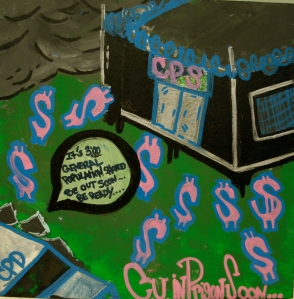“Our schools have become almost like satellite police stations.” – Steve Drizin

From Representing the Pipeline (7/31/10)
“Policing Chicago Public Schools: A Gateway to the School-to-Prison Pipeline” written by Mariame Kaba & Frank Edwards relies on data from the Chicago Police Department (CPD) to show (for the first time in seven years) the type of offenses and the demographics (gender, age and race) of the juveniles arrested on CPS property in calendar year 2010. We are limited because CPD reports data by police district rather than by individual school. A FOIA request filed by First Defense Legal Aid to the Chicago Public Schools requesting school-level arrest data has gone unfulfilled even after several months.
In the 2003-2004 academic year, CPS had about 1,700 security staff, nearly tripling in number in five years. We were unable to obtain the current number of security guards in CPS despite repeated requests. We are sure that this number exceeds the 1,700 from the 2003-2004 academic year. The presence of so many security staff and especially police officers in schools means that school discipline issues quickly turn into police records.
In our discussions about the school-to-prison pipeline, we need concrete examples of how the process works. As such, it is important to understand the role that police and security staff play in our schools. Yet reports about police involvement in CPS have unfortunately not been readily available to the public. There is no easily accessible citywide or statewide data that illustrate how many students are arrested in schools each year. The last report that was written about the role of police in Chicago Public Schools was published in 2005 by the Advancement Project. That report, “Education on Lockdown,” found that Chicago Public Schools (CPS) referred over 8,000 students to law enforcement in 2003. Forty percent of these referrals were for simple assault or battery with no serious injuries. Most of these cases were dismissed.
Our purpose in writing this report is to ensure that the public is informed about the scope and extent of policing in Chicago Public Schools. We hope that this will galvanize educators, parents, students, policymakers and community members to advocate for a dramatic decrease of CPS’s reliance on law enforcement to address school discipline issues. Instead, we would like to see an increase in the use of restorative justice, which is an effective approach, to respond to student misbehavior in our schools.
In light of a push for budget austerity, limited resources should be re-directed away from policing and into affirming programs and opportunities for students. This, we believe, will improve the overall well-being of all stakeholders in the educational system (most especially students). We also call on our city council to improve data transparency by passing an ordinance requiring CPS and CPD to report quarterly on the numbers of students arrested in the district. Having timely and reliable information will support efforts to hold CPS and CPD accountable. Finally, we believe that student privacy should be protected rather than further eroded. Current reporting practices between schools and law enforcement do not need to be reformed to increase the exchange of student information between these parties.
The key findings in this report include that:
There were 6,430 total arrests on Chicago Public School properties in 2010;
Of these, 5,574 were juvenile (under 18 years old) arrests on Chicago Public School properties. School-based arrests of youth accounted for 20 percent of all juvenile arrests (27,563) in the city of Chicago in 2010.
Black youth accounted for 74 percent of juvenile school-based arrests in 2010; while Latino youth represented 22.5 percent of these arrests. 45 percent of CPS students are African American while 41 percent are Latino (CPS, 2009). This suggests that black students are disproportionately targeted for arrest in CPS.
Nearly a third (27%) of juvenile school-based arrest offenses is simple battery. This suggests that a significant number of CPS students are probably being arrested for fighting.
The highest aggregate numbers of juvenile school-based arrests are in the 4th, 6th, 8th, 22nd, and 5th police districts. Together these five districts account for 39% of total juvenile school-based arrests on CPS property.
For any questions about this report, please contact Project NIA at projectnia@hotmail.com.


